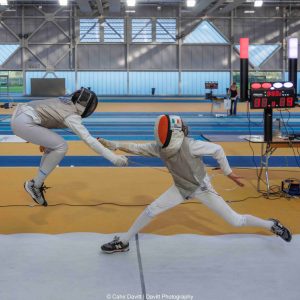
The parents’ guide to competitions
When should you start competing?
It does help to know which end of a sword to hold, and which to poke with! At least 6 months of regular attendance at a club is probably about right. After that the best time is when you feel ready – if you wait until you think you can win, you will probably wait forever – while you are practising and perfecting your skills, there are other fencers out there doing the same thing, and getting competition experience at the same time. They might not be winning, but they will be improving faster than by club training alone!
Tips for the parents

- To register for a fencing competition, first of all, you need to get an Irish licence. You can get it online at https://irishfencing.net/licence-application/, it is free of charge for children.
- Then check competitions in Youth Calendar: https://irishfencing.net/youth-fencing/youth-calendar/
- Pembroke holds 3 children`s competitions in Dublin and there are 6 competitions in NI, Junior Foil Series.
- To register your child for competition in Dublin please contact Pembroke Fencing Club by email
- Registration for NIJS: https://www.nifencing.com/events/
- To compete in NI need to have a full fencing kit with you (mask, jacket, under plastron, glove, 2 foils, 2 body wires, lame), if you compete in Dublin, you can rent the gear from Pembroke FC for 10 euros.
- Check the age categories carefully. Fencing age groups are based on ages from 1 January in the current year which means that a child who is eleven on 2 January can continue to compete as a U11 for the rest of that year.
- Take plenty of drinks. In all the kits, fencers get hot and children dehydrate quickly. Avoid fizzy drinks.
- Some fencers eat lots at a competition, others feel too nervous. Lots of chocolate and sweets are best avoided, but bananas, dried fruit and cereal bars provide energy and are not too messy.
- The time shown on the application form is for start. Check-in starts 30 minutes earlier, but if you are not there for the check – your entry will probably be scratched Take a good book. You will spend lots of time sitting around! Folding chairs are also popular.
- If your child fences foil or sabre, and you are new to fencing, ask someone to explain the Right of Way rule. Inexperienced parents can get upset when their child’s light comes up before their opponent’s but the hit is given against them!
- Wear trainers or similar. Many venues don’t allow outdoor shoes in the sports hall.
- Keep younger children away from the action.
- Whilst the organisers of each event make every effort to ensure that the competitions are safe and secure, the responsibility for the welfare of the child remains with the parent or nominated responsible adult (acting in loco parentis). If, as a parent or coach, you decide to leave children in your care at an event for the day please ensure that the organisers are aware of the responsible adult that is looking after your care.
- Enjoy!
Tips for the fencers

- Warm up thoroughly before your first bout and again if there is a gap of more than about 15 minutes between bouts.
- Remember “Fencing Etiquette”. Salute your opponent and the referee at the beginning of the fight and shake hands at the end.
- When you are not fighting, stay near your pool. Fights can finish very quickly, and referees get annoyed when fencers vanish!
- If you don’t understand a decision, ask politely for the referee to explain it, but don’t argue.
- At the end of the pools, check the pool sheet to ensure that your results are recorded correctly. It’s much easier to sort out mistakes if they are picked up immediately.
- Try not to show excessive pleasure in winning a hit or bout, or bad temper on losing one. Throwing down masks or swords is considered very bad sportsmanship.
How does competition work?
The format of a tournament is broken down into two main sections of bouting. The preliminary round (also called the ‘pools’) divides fencers up into different groups. All fencers in each group fence against each other (also called ‘round robin’ format) and based on their results, the tournament organizer can determine how to rank (also called ‘seeding’) those fencers for the direct elimination round.
The direct elimination round (also called the ‘DEs’), consists of a bracket of fencers competing against each other. A standard DE bout lasts for 3 periods of 3 minutes each, or a maximum of 15 touches*. The reason this round is referred to as the ‘direct elimination’ round is that after only one loss, a fencer is out of the tournament, and their final placement is determined by the round in which they were defeated. The last fencer standing wins the entire tournament.
Round of Pools
The purpose of the preliminary rounds is to rank (aka ‘seed’) fencers for the DEs. The total number of starting fencers in the competition is broken down into smaller groups, usually, 7 people, called ‘pools.’ Each athlete fences everyone in their pool for a total of 6 bouts. How well a fencer does in their pool is then compared to how everyone else in the tournament did in their respective pools. Note that pools do not have to contain 7 people, and due to the fact that tournaments often do not have an exact multiple of 7 participants, many tournaments will run pools of both 7 and 6* fencers at the same tournament. In the pools of 6 fencers, each fencer would then fence only 5 total bouts.
- Fencers are first grouped by their win percentage (This is equal to the fencer’s number of bouts won divided by the fencer’s total number of bouts)
- Any ties in ranking based on win percentage are broken by each fencer’s indicator
- And remaining ties in the ranking are broken by the total number of touches scored (i.e. the same number used in part to calculate the indicator)
- If all of the above are tied, then fencers tie out of the pools and seeding for the DEs is determined randomly.
Epee and Foil bouts are fenced in a set of three periods. Each period lasts for three minutes of fencing time. Fencing time is the time between when the referee says ‘fence!’ and when a light on the machine is turned on. The timer is paused between touches. After each period, fencers get a 1-minute break, during which they can rest, drink water, and speak with their coach. The score is not reset between periods. Fencing concludes after the 3rd period, or when a fencer scores 15 touches, whichever comes first.
Format
The direct elimination rounds are composed of a single bracket of all the fencers that were promoted from the round of pools (in many cases, all fencers that participated in pools). These fencers then compete head-to-head to determine their final ranking. The bracket is often referred to in the fencing community as the ‘tableau.’ Each time a bout occurs, the winning fencer advances to the next round, and the losing fencer is eliminated*. For this reason, the rounds are composed of a number of fencers equal to exponents of two: there is a round of 2, 4, 8, 16, 32, 64, 128, and 256 (most tournaments will not be larger than this).
Within each round, the format is set so that the lowest-ranking fencer competes with the highest-ranking fencer in that round. For example, in the round of 128, the fencer ranked 1st will be matched up against the fencer ranked 128th. The fencer 2nd will be matched up against the fencer ranked 127th, and so on all the way up to the fencer ranked 64th facing off against the fencer ranked 65th.
This format ensures that, given no upsets (where a lower-ranked fencer defeats a higher-ranked fencer), each person will finish the tournament according to their rank. If there are not enough fencers to fill up a round, then the highest-ranking fencers will receive free passes into the next round (known as ‘byes’).
After a full round is completed, and one fencer advances from each match, the next round will have half as many competitors as the previous (because one fencer was knocked out of each match of two fencers). So if a fencer consistently wins several matches in a row after beginning in the round of 128, they will enter (respectively) the top 64, then the top 32, then the top 16, then the top 8, etc. Note that when an ‘upset’ occurs (a lower-ranked fencer defeating a higher-ranked fencer), the winner ‘takes over’ that spot on the tableau and continues fencing along that path.
Final placement in a competition
After a fencer loses a DE bout, their final ranking will be somewhere within the range of the round. For example, if Levy loses his next bout in the round of 8, his placement will be somewhere between 5th and 8th (because he made it into the round of 8, but didn’t quite make the round of 4). Final rankings of fencers within the same round are determined by their seeding after the round of pools. The one exception to this rule is in the round of 4. At most tournaments, fencers will simply tie for 3rd place.
Direct Elimination
Group Hits Time Limit
Youth A 8 6 minutes
Youth B 8 6 minutes
Youth C 10 6 minutes
Intermediate 15 9 minutes
Cadets 15 9 minutes
How Often Should Your Child Compete in Fencing?

Deciding how much a young fencer should compete can be a challenge for parents and kids to figure out. There are lots of variables that factor into how often young fencers step onto the strip for competition – the desire of the kids, the desire of the parents, fencer level, readiness, region (and therefore accessibility to fencing tournaments), and so many more factors that are individual to a family.
Parental considerations
Kids, though they’re the ones doing the actual fencing, are only one of the driving forces behind how much time they spend in competition. Parents are another important driving force in this, and sometimes the most important one. Some parents are all over the place in terms of how they interact with their young fencers and fencing competitions.
On one side of the spectrum, some parents think that competition in and itself will be too much of a discouraging experience for their child, so they intentionally keep them away from fencing competitions as much as possible. They either never sign their kids up for a competition or they rarely sign them up. What they’re really afraid of is that their child will lose and so their self-esteem will take a hit.
On the other side of the spectrum are parents who push their kids to attend tons of competitions, both big and small, both local and far away, weekly. These kids are out every week during the season, constantly competing all over the place.
Both of these are wrong.
Competition in fencing, just as everything else in life, demands balance. Parents who give their kids the best experience and maximize their young fencer’s growth through the sport are those who allow them to balance learning how to cope with loss and boosting self-esteem through hard-earned victory. That means competing enough to learn all of those lessons.
There are a great many hefty considerations for parents that we recognize when it comes to how many competitions their children participate in each year. Here we want to be clear – families must make decisions based on their values, their time commitments, and financial realities. What’s important is that parents look with a critical eye at how they’re deciding for their young fencers to participate in the competition, and then be open to finding the right balance for their needs.
Why all kids should compete
We firmly believe that all kids should compete, even if it’s only rarely. Here’s why:
- Check themselves
- Understand why they train
- Identify and work toward goals
- Challenge themselves
- Learn how to lose and how to win
- Meet other fencers
- Show their skills for family and friends
ALL fencers benefit from competing. That’s just an across-the-board truth. The feeling of competing in fencing is fundamentally different from what happens for fencers when they are only training in the club. Even kids who say that they are “recreational” only as fencers should participate in competitions from time to time. It could be an in-house club competition, a school meet, or a small local tournament. It might only be twice a year!
The point here is that every child should experience fencing competition as part of their fencing experience, no matter what their larger goals are for fencing in general. Even if they only compete twice a year, they’re still able to test their skills and calibrate their training. With the right preparation, fencers who compete very rarely will have a lot of fun and will fuel their passion for the sport.
Why too much competing is too much
Though we want to see every child fencing in competition at least a couple of times each year, on the other side there are those young fencers who compete too much. Spending an overly ambitious amount of time competing can hurt kids, for so many reasons.
Here are the main reasons that too much fencing competition is a bad idea.
- Burn out
- Loss of perspective
- Inability to recover physically or mentally
- Inability to maintain training balance
- Diluting the value of competition
- Chasing the wrong goal – ie medals or rank
- Blowing budget
- Increased risk of injury
- Losing the thrill of competition – it becomes routine
Even if your child is chasing the dream of becoming a fencer with a national or international title, more competition is not necessarily better. The reality is that fencers who just go to every competition available to them without thinking about a plan for why they’re attending those competitions are not going to reach their goals.
Remember, fencing is just as much of a mental game as a physical one. Not only do we want to be smart about the way that we approach our opponent on the strip, but we also want to be smart about the way that we approach finding those opponents in the realm of competition!
So what’s the right balance?
Now we get to the good stuff – what is the right balance for fencers to compete?
Let’s look at the best fencers in the world, the most successful fencers. How do they compete? How do they train? We can learn from their circle and then try to apply that to kids in fencing.
Here’s an example. There are world-level competitions – think World Cups, Grand Prix and World Championships – about once per month. There are five World Cups, three Grand Prix, one European Championship and one World Championship. That’s a total of ten each year. In addition to those, top fencers usually compete in one to three national tournaments during each season. Add all of that up and these top fencers are competing once a month, one weekend in four.
What about all of that time in between those competitions? What in the world are they doing if they aren’t competing? That’s pretty easy to figure out. Here’s EXACTLY what those top fencers are doing:
- Train
- Prepare
- Restore
It’s easy to think that competition is where the action is because it’s the most visible aspect of the whole process, but the VAST majority of the time that athletes spend is not on competition, but rather on getting ready for it. It’s this silent time, this invisible time, that’s lost on people who aren’t part of it. If we take that method of senior-level fencers and extrapolate it down to kids, then what does it look like? Of course, it will vary depending on the level of the child and their commitment to the sport, but this can offer us a baseline. Let’s look at the two ends of the spectrum of kids in fencing, keeping in mind that within these there are relative beginners, moderate, and highly competitive kids.
Kids who want to be serious fencing competitors
We want to see a maximum of two competitions per month for competitive kids. Of course, depending on the calendar that might be a challenge as sometimes one large competition is followed directly by another, but these are general guidelines.
- One big competition every two months
- One smaller competition between every two big ones, like a local tournament.
Beginners who want to try out the competition
It’s important for kids who think that they might want to compete to try it out, but slower, in the beginning, is a good idea. That means competing every few months instead of multiple times in a single month to start with, allowing more time and energy to build the skills and training regimen that works best for them individually. Smaller competitions for young fencers who are new to the sport are the rule, so go with in-house or local tournaments early on.
- One competition per quarter
Kids who want to fence for recreation
Again, even recreational fencers should compete for a wide variety of reasons. Whether the child is fencing to improve their mental and physical acuity, to learn a new skill, or just for the sheer joy of it, competing undoubtedly enriches the fencing experience.
- Two local competitions per year
Always, always remember that these are guidelines only based on our experience and our analysis of fencing as a sport – talk to your child’s coach and create a plan that’s suited to their particular interests. Fencing is an individual sport! Your child’s competitive path will be highly individual.
The main thing that we want to see is that young fencers are engaged in and excited about the sport. Competition is a major part of that process in fencing, not only because it supports fencer’s development in the sport but because competition in and of itself is a growth experience. No matter their level, healthy competition generates improvement in skill and supports the growth of positive self-esteem. Even if a fencer loses the bouts they participate in, she or he will still score a touch and can be proud of the performance.
Parents can help their young fencers to create a balanced competition schedule that’s right for everyone, no matter what their competitive level may be.
